The Fallen-Royal Navy (in chronological order)
Herbert Lyne GEOGHEGAN (died 1916 at the Battle of Jutland)
Fleet Surgeon and
Joseph James BONCEY (died 1916 at the Battle of Jutland)
Royal Marine
The Battle of Jutland, fought on 31 May – 1 June 1916, was the ultimate clash of the British and German battle-fleets in the First World War. Both sides claimed a victory. 2,554 German seamen died; and 6,094 British. Among the latter were 2 men from Rowlands Castle.
Herbert Lyne Geoghegan (pronounced Jagan) was brought up in Germany, and fluent in German. He took a first degree in Queen’s College, Galway and an MD in Trinity College, Dublin. He started his nautical career as a doctor aboard the ships of the Pacific Steam Navigation Company (PSNC), carrying passengers and freight on the route from Liverpool, round Cape Horn to Valparaiso, Chile, with calls at intermediate ports (Lisbon, Buenos Aires, occasionally the Falkland Islands. The Panama Canal was not yet built). He made 5 round trips.
In 1899, several of the PSNC ships were taken up as troop ships for the Boer War. Herbert joined the Royal Navy as a Surgeon. He spent some time ashore, at the Royal Naval Barracks, Portsmouth, and latterly, at the Royal Marines Depot at Deal, caring for the young Marines under training.
During his time ashore he translated into English the German book Bacteria by Dr Max Schottelius (in its day a useful introduction for doctors).
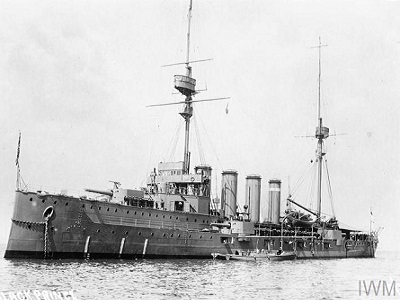
Following promotion to Fleet Surgeon, he was appointed at the start of the war as the Principal Medical Officer of BLACK PRINCE, an armoured cruiser of 13,350 tons, launched at the Thames Iron Works in 1904.
She carried a main armament of six 9.2 inch guns, each in a separate turret. (Photo IWM Q75294 by Ernest Hopkins)
Joseph James Boncey is one of the 3 Boncey brothers whose names are also recorded on our War Memorial. Joseph joined the Royal Marine Light Infantry (RMLI) as a Regular, and was trained at Deal. (His brothers were respectively, a corporal in the Royal Sussex Regiment, and a Petty Officer Stoker in the Royal Navy).
Joseph was appointed to the battle-cruiser INVINCIBLE (17,250 tons). Like the revolutionary all-big-gun DREADNOUGHT (ten 12-inch guns), launched in 1906, INVINCIBLE was a product of the fertile mind of Admiral ‘Jackie’ Fisher. The INVINCIBLE carried the same big guns as a Dreadnought (eight 12-inch guns in 4 turrets), but carrying less armour, was significantly faster. Fisher said ‘Speed is Armour!’ INVINCIBLE, first of her class, was launched in 1907. The Royal Marines formed the crew of one such turret at Jutland.
British wireless intercept and code-breaking ensured that Admiral Jellicoe with the Grand Fleet left Scapa Flow (and Admiral Beatty with the battle-cruisers left Rosyth) well in advance of the German Admiral Scheer sailing with the High Seas Fleet from Wilhelmshaven. The German battle-cruisers under the command of Admiral Hipper left Wilhelmshaven an hour ahead of Scheer (around 1am on 31 May). The 2 battle-cruiser forces met around 3.30pm. The Germans opened fire at 3.48pm. The battle-cruiser INDEFATIGABLE blew up at 4.02pm, 1,017 officers and men being lost, 2 saved. Her sister QUEEN MARY blew up at 4.26pm, (1,266 officers and men lost 20 saved). The 2 battleship forces came into contact only at 6.15pm. Admiral Jellicoe, flying his flag in IRON DUKE, gave the order to deploy into line-of-battle. The 4 armoured cruisers, scouting ahead of the Grand Fleet, were scattered. (DEFENCE was sunk, WARRIOR badly damaged, sinking later, BLACK PRINCE wounded and forced to withdraw. Only DUKE OF EDINBURGH escaped).
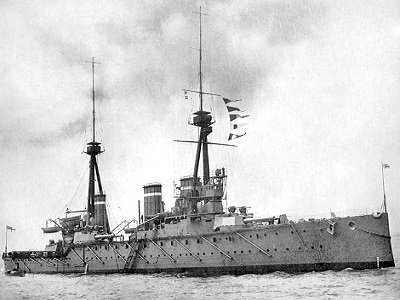
ININCIBLE, flying the flag of Rear Admiral Hood, led the 3rd Battle-cruiser squadron between the 2 fleets, but was blown in two by a magazine explosion at 6.32pm. 1,026 officers and men were lost.
Amongst the 6 survivors were the ship’s gunnery officer, Commander Dannreuther, who saw the German shell penetrate ‘Q’ turret (that manned by the Royal Marines), exploding inside and blowing the armoured roof off, followed by the bigger explosion which split the ship. Also saved was a much wounded and burnt Marine Gasson, the turret range-taker.
After dark, the action was largely over. Both British and German fleets headed south-east, towards Wilhelmshaven. At 10 minutes after midnight, BLACK PRINCE blundered into the German battleships, and was engaged by at least 3 of them at close range. Her aft turret was blown overboard, a fire started, and the ship blew up with 2 large explosions. All 857 officers and men were lost.
The names of both men are also recorded on the Royal Naval memorial on Southsea common.
Sam SHEPARD (died 1916 in the Baltic)
Chief Petty Officer Submariner
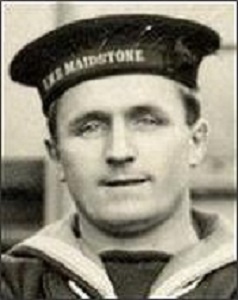
Chief Petty Officer Sam Sheppard, born in 1880 in St Neots, died with all his shipmates aboard HM Submarine E 18, in a little-known naval campaign in the Baltic in 1916.
A bright lad, his first job was as the driver of a horse-drawn public omnibus. In 1898, Sam joined the Royal Navy as a stoker. His first ship was HMS DUKE OF WELLINGTON, 131 guns (Trafalgar style). Here Sam learnt to sling his hammock, and salute. Sam did his basic engineering training in HMS ALEXANDRA, a more modern vessel, starting with shovelling coal, in the bunkers and at the boiler furnace door. Once qualified, Sam moved to destroyers, first at Chatham, based on the depot ship HMS LEANDER, and then out to Malta.
In 1905 Sam volunteered for the Submarine service (which was formed in 1901). He joined the submarine depot ship HMS THAMES at Harwich, starting his training in one of the first Holland-class boats. No more stoking! The Holland, and the subsequent A, B and C classes had petrol engines for use on the surface. Later boats used diesel engines. Sam did well, soon rated Leading Stoker. Sam went back to General Service in 1910 (as was the custom). As a Petty Officer Stoker he joined the battleship HMS SWIFTSURE (11,800 tons).
At the start of the Great War, Sam, now a newly-promoted Chief Petty Officer Stoker, came back to HMS DOLPHIN (Gosport) to learn about the new E-class boats (640 tons, 5 torpedo tubes), before (June 1915) joining the depot ship HMS MAIDSTONE at Harwich, for HM Submarine E 18. As Chief Stoker, Sam was the Engineer Officer of this (then) very modern submarine! The Commanding Officer was Lieutenant Commander Robert Halahan, the First Lieutenant Walter Landale (grandfather of the BBC reporter). There was only one other officer, Sub Lieutenant Colson. They were bound for the Baltic.
Denmark and Sweden were neutral in this war. Germany had just widened the Kiel canal. German and Russian land forces were fighting on the southern shore around the Gulf of Riga. Ice limited movement of ships and submarines midwinter. Their main target was the flow of iron ore from Sweden to German ports. The then current Law required our submarines to surface, and view ship’s papers, before sinking a merchant ship. Torpedoes were reserved for German warships. Halahan received his orders from a Russian Commodore by wireless. He therefore embarked a Russian Liaison officer, Lieutenant Vasily Polykarpov, and 2 Russian telegraphists.
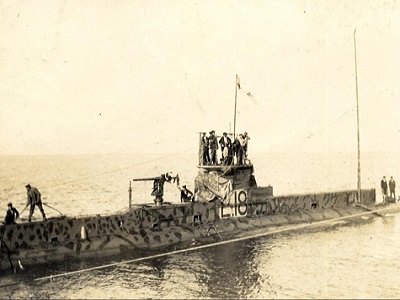
E18 entered the Baltic on 12 September 1915, together with E13 and E19. E13 ran aground, and was lost. The others made for our Baltic base, Reval (now Tallinn in Estonia).
Good work was done over the autumn. The winter was spent iced up in Reval. E18 was able to sail again in April 1916, when she took the Russian Commodore to the Gulf of Riga, to witness a bombardment of German land forces by Russian destroyers. E18 sailed from Reval for the last time in May 1916. On 26 May Halahan blew the bows off the new German destroyer V100 with a torpedo. The Germans reported him off Memel on 28 May. He failed to return from patrol.
Resolution
In October 2009, the Swedish research vessel Triad located E18 off the island of Hiiumaa, at the north end of the Gulf of Riga. Divers confirmed that hull damage was compatible with a moored mine explosion amidships.
Remembrance
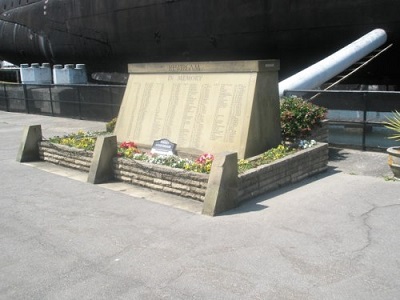
Sam is remembered on our memorial. Sam and his shipmates are also remembered on the naval memorial at Southsea, and the memorial in the Submarine Museum.
All are remembered, including the 3 Russian men, in the Church of the Holy Spirit in Tallinn, and by the E18 Families Group, run by a descendant of Robert Halahan.